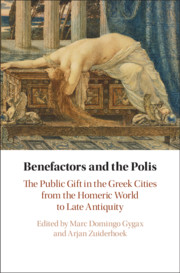 Benefactors and the Polis
Benefactors and the Polis Book contents
- Benefactors and the Polis
- Benefactors and the Polis
- Copyright page
- Contents
- Figures
- Tables
- Contributors
- Acknowledgements
- Abbreviations
- Introduction
- Part I Benefiting the Community in Early Greece
- Part II Classical Benefactors
- Part III Hellenistic Benefactors
- Part IV Benefactors and the Polis under Rome
- Chapter 8 Emperors, Benefaction and Honorific Practice in the Roman Imperial Greek Polis
- Chapter 9 Benefactors and the Poleis in the Roman Empire
- Chapter 10 Festivals and Benefactors
- Part V The Decline and Fall of Euergetism?
- Conclusion
- Index
- Index locorum
- References
Chapter 8 - Emperors, Benefaction and Honorific Practice in the Roman Imperial Greek Polis
from Part IV - Benefactors and the Polis under Rome
Published online by Cambridge University Press: 21 January 2021
- Benefactors and the Polis
- Benefactors and the Polis
- Copyright page
- Contents
- Figures
- Tables
- Contributors
- Acknowledgements
- Abbreviations
- Introduction
- Part I Benefiting the Community in Early Greece
- Part II Classical Benefactors
- Part III Hellenistic Benefactors
- Part IV Benefactors and the Polis under Rome
- Chapter 8 Emperors, Benefaction and Honorific Practice in the Roman Imperial Greek Polis
- Chapter 9 Benefactors and the Poleis in the Roman Empire
- Chapter 10 Festivals and Benefactors
- Part V The Decline and Fall of Euergetism?
- Conclusion
- Index
- Index locorum
- References
Summary
This chapter investigates the dynamics of material and symbolic exchange between Roman emperors and Greek cities, and the role of the emperor in the ideology and practice of civic euergetism in the Greek East, in the middle Roman empire (c. 98–180 CE). It begins by documenting the absence of demonstrable correlations between (1) an imperial visit and an imperial benefaction to a city and (2) an imperial visit and the erection of an honorific statue for the reigning emperor. On this basis it is argued that an imperial visit was not the critical moment for generating reciprocal exchanges between emperor and city, as is normally thought, and that local honours for the emperor were not usually triggered by the provision or even the prospect of specific imperial benefactions to the city. The bulk of the chapter then draws out the implications – both ideological and practical – of this peculiar form of ‘abstract reciprocity’ between Roman emperors and Greek cities, arguing that this type of idealized benefaction and local honorific practice defines this phase in the long history of civic euergetism in the Greek polis.
Keywords
- Type
- Chapter
- Information
- Benefactors and the PolisThe Public Gift in the Greek Cities from the Homeric World to Late Antiquity, pp. 201 - 221Publisher: Cambridge University PressPrint publication year: 2021


